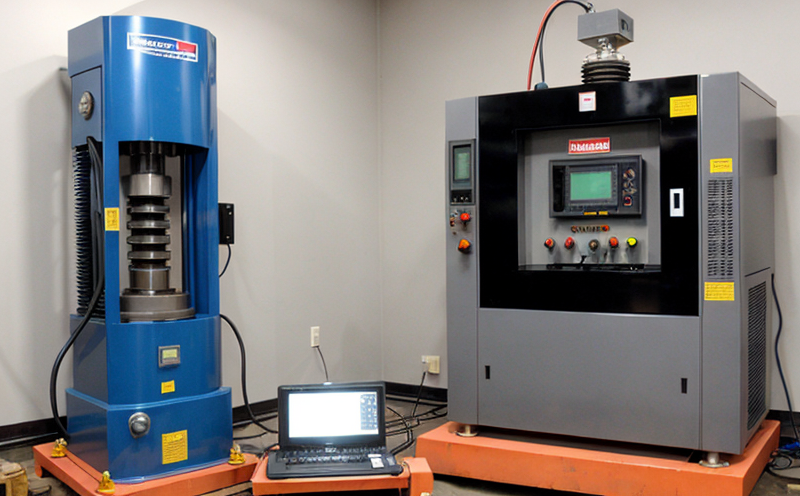ISO 13355 Packaging Random Vibration Test
The ISO 13355 packaging random vibration test is a critical procedure aimed at ensuring the durability and integrity of electronic packages under simulated environmental conditions. This test evaluates how well a package can withstand mechanical shock and vibration, which are common in real-world environments such as transportation, handling, and storage.
The standard provides guidelines for testing packaging systems to ensure they meet or exceed the specified performance criteria. The test is particularly important for industries where product reliability under harsh conditions is paramount, including aerospace, automotive, consumer electronics, and telecommunications. By simulating the random vibration environment that a package might encounter during its lifecycle, manufacturers can identify potential weaknesses in their designs.
The testing process involves subjecting the packaging to controlled levels of random acceleration across various frequency ranges. The test setup typically includes an environmental chamber equipped with a shaker capable of generating vibrations at specific frequencies and amplitudes. Specimens are placed inside the packaging, which is then subjected to the vibration environment for a predetermined duration.
The primary objective of this testing procedure is to ensure that the packaging can protect its contents from damage due to mechanical stress. The test helps manufacturers identify potential issues in their design and manufacturing processes, allowing them to make necessary improvements before product release. This not only enhances product quality but also reduces warranty claims and product failures post-market.
The ISO 13355 standard specifies the conditions under which testing should be conducted, including frequency ranges, acceleration levels, and duration of exposure. Compliance with these standards ensures that products meet international quality benchmarks and are suitable for global markets. The test results provide a clear indication of the packaging's ability to protect its contents against environmental stresses.
Manufacturers who undergo this testing can demonstrate their commitment to product reliability and customer satisfaction, thereby building trust and reputation in competitive marketplaces. This is particularly important in sectors where brand image and product integrity are crucial for success. By adhering to the ISO 13355 standard, companies can ensure that they meet or exceed regulatory requirements, which is essential for maintaining compliance with international standards.
The test results also provide valuable insights into the performance of various packaging materials under different vibration conditions. This information can be used to optimize material selection and improve design iterations, leading to more robust and efficient packaging solutions. The data obtained from these tests can be instrumental in the development of new products or improvements to existing ones.
The ISO 13355 standard is widely recognized for its rigorous approach to ensuring product integrity under simulated environmental conditions. By following this procedure, manufacturers can enhance their competitive edge and ensure that their products meet the highest quality standards. The test results provide a robust basis for decision-making in R&D processes, helping companies to stay ahead of market trends.
Applied Standards
- ISO 13355: Packaging - Random vibration test methods (for packaging systems intended for the transport and storage of products in transit)
The ISO 13355 standard provides comprehensive guidelines for conducting random vibration tests on packaging systems. It specifies the frequency ranges, acceleration levels, and duration of exposure that should be used during testing to ensure accurate evaluation of a package's durability under simulated environmental conditions.
This standard is particularly relevant in industries where product reliability is critical, such as electronics manufacturing, aerospace, automotive, and telecommunications. By adhering to the ISO 13355 standard, manufacturers can demonstrate their commitment to quality and compliance with international standards. The test results provide a clear indication of the packaging's ability to protect its contents against environmental stresses, thereby enhancing product reliability.
The standard is widely recognized for its rigorous approach to ensuring product integrity under simulated environmental conditions. Compliance with ISO 13355 ensures that products meet international quality benchmarks and are suitable for global markets. The test results provide a robust basis for decision-making in R&D processes, helping companies to stay ahead of market trends.
Customer Impact and Satisfaction
The ISO 13355 Packaging Random Vibration Test plays a crucial role in enhancing customer satisfaction by ensuring that products meet the highest quality standards. By adhering to this standard, manufacturers can demonstrate their commitment to product reliability and compliance with international benchmarks.
- Ensures product integrity under simulated environmental conditions
- Reduces warranty claims and post-market failures
- Enhances brand reputation and customer trust
- Facilitates compliance with international standards
The test results provide a robust basis for decision-making in R&D processes, helping companies to stay ahead of market trends. This not only enhances product quality but also reduces costs associated with rework and recalls, ultimately leading to increased customer satisfaction.
Environmental and Sustainability Contributions
The ISO 13355 Packaging Random Vibration Test contributes positively to environmental sustainability by promoting the use of materials that are more durable and efficient. By identifying potential weaknesses in packaging designs early on, manufacturers can make necessary improvements, reducing the need for excessive materials or over-engineering.
This approach not only enhances product reliability but also promotes resource efficiency and waste reduction. The test results provide valuable insights into material performance, enabling companies to select more sustainable options that meet both quality and environmental goals.





